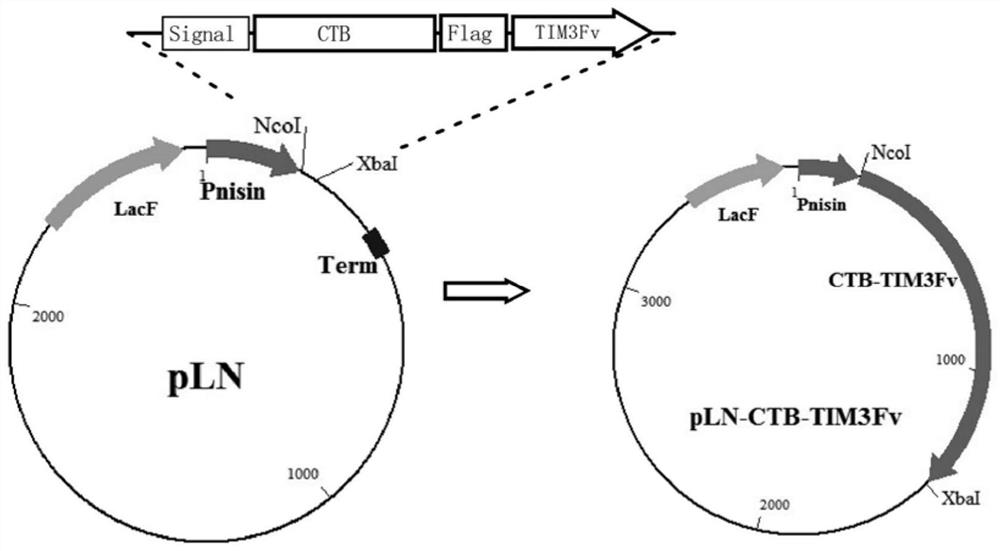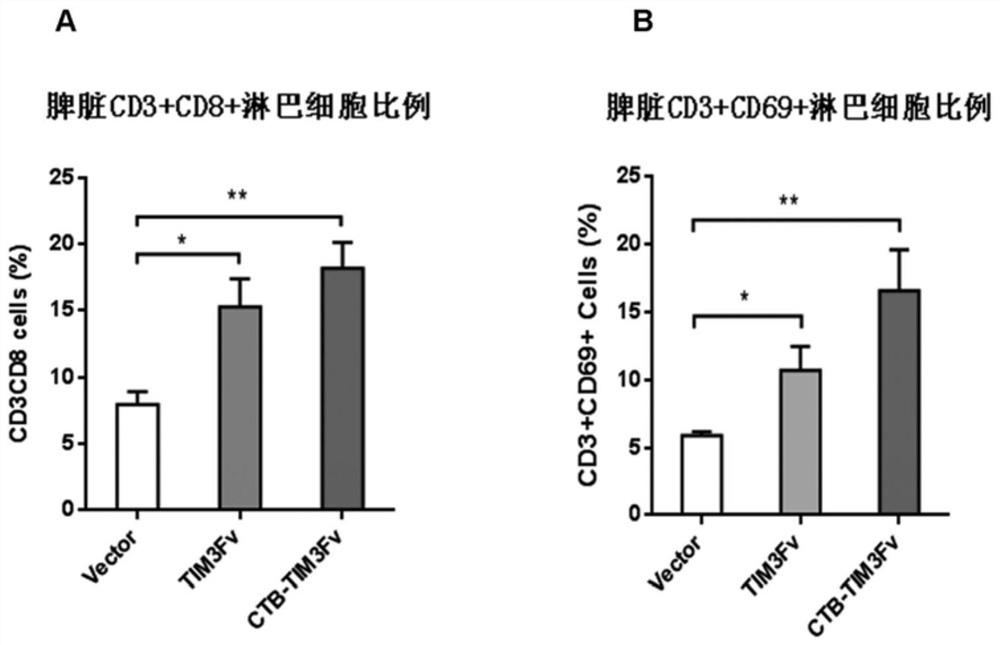Transformation of lactic acid bacteria with tim3 human single chain antibody fusion gene and its application
A technology of fusion gene and TIM-3, applied in the direction of antibodies, applications, antibacterial drugs, etc., can solve the problems of high production cost and inconvenient medication, and achieve the effect of improving the level of cellular immunity in the body
- Summary
- Abstract
- Description
- Claims
- Application Information
AI Technical Summary
Problems solved by technology
Method used
Image
Examples
Embodiment 1T
[0065] Preparation, screening and identification of embodiment 1 TIM3Fv and CTB-TIM3Fv fusion gene transformed lactic acid bacteria
[0066] 1. Synthesis and recombination of TIM3Fv and CTB-TIM3Fv fusion genes
[0067] (1) According to the amino acid sequence of the SPK1 signal peptide, the codons were optimized to make it suitable for high-efficiency expression in lactic acid bacteria, and the cDNA sequence of the SPK1 gene (SEQ ID NO: 1) was designed.
[0068] (2) Design the complementary DNA gene sequence according to the amino acid sequence and functional region structure of the TIM3 human antibody, and connect the heavy chain variable region (VH) and light chain variable region (VL) through a connecting peptide (Linker) and Flag tag sequence The connection forms the TIM3Fv gene, and the codon is optimized to make it suitable for high-efficiency expression of lactic acid bacteria (SEQ ID NO: 2).
[0069] (3) According to the CTB gene sequence, its codons were optimized to...
Embodiment 2
[0080] Example 2 Application of TIM3Fv and CTB-TIM3Fv transformed lactic acid bacteria live bacteria in the prevention and treatment of subcutaneous transplanted tumors of renal adenocarcinoma in mice
[0081] (1) Establishment of mouse kidney cancer RAG xenograft model
[0082] Select 8-week-old healthy male BABL / c mice with a body weight of 18-20 g, and in vitro cultured RAG mouse renal adenocarcinoma suspension (about 1×10 6 1) injection and inoculation into each mouse subcutaneously, and the bacteria powder was fed for treatment after the mouse transplanted tumor grew to a diameter of 0.5 cm.
[0083] (2) Cultivation of transformed bacteria
[0084] Use EM medium to resuscitate TIM3Fv and CTB-TIM3Fv to transform lactic acid bacteria strains (obtained in embodiment 1), after the bacteria reach a certain concentration, inoculate in the EM medium according to a certain ratio (1:100-500), wait for the bacterial density to reach OD 600 Bacteria were collected at 0.6-1.0.
[...
Embodiment 3
[0100] Example 3 Application of TIM3Fv and CTB-TIM3Fv Transformed Live Lactic Acid Bacteria in the Prevention and Treatment of Primary Colorectal Cancer
[0101] (1) The methods of TIM3Fv and CTB-TIM3Fv transformed lactic acid bacteria recovery, cultivation and preparation of viable bacteria powder are the same as those in Example 2.
[0102] (2) Construction of colorectal cancer APCmin / + model
[0103] APCmin / + male mice and C57BL female mice were selected and housed together in a ratio of one male and three females per cage. After 2 weeks after the birth of the suckling mouse, cut the toe marks, and cut off a small piece of tail or a small piece of ear. Genomic DNA was extracted by conventional methods, and the target DNA fragment was amplified by polymerase chain reaction (PCR) according to the method of Nanjing Model Animal Resource Bank to identify APCmin / + heterozygotes. Only 700bp band in the PCR product is wild-type mouse; only 300bp band is mutant homozygous mouse; ...
PUM
 Login to View More
Login to View More Abstract
Description
Claims
Application Information
 Login to View More
Login to View More - R&D
- Intellectual Property
- Life Sciences
- Materials
- Tech Scout
- Unparalleled Data Quality
- Higher Quality Content
- 60% Fewer Hallucinations
Browse by: Latest US Patents, China's latest patents, Technical Efficacy Thesaurus, Application Domain, Technology Topic, Popular Technical Reports.
© 2025 PatSnap. All rights reserved.Legal|Privacy policy|Modern Slavery Act Transparency Statement|Sitemap|About US| Contact US: help@patsnap.com



